- Now Frolic
- Posts
- Where Voices Rise and Art Thrives
Where Voices Rise and Art Thrives
From a March Against Domestic Violence to a Celebration of Local Art, West Reading Supports Its Community
Shortly after 9:30 a.m. on Saturday, June 21, chants of “No more silence! End the violence!” echoed down Penn Avenue in West Reading, Pennsylvania. I was among the hundreds participating in the Safe Berks Walk for NO MORE – an annual public demonstration against domestic violence and sexual assault. Clad in purple T-shirts, the crowd stepped off near 8th Avenue beneath the morning sun, marching east with steady conviction. Call-and-response chants — “No more domestic violence… No more sexual assault!” — rang out as the procession made its way through town.
The walk marked a powerful start to a full day in West Reading that blended civic purpose with creative celebration. As the final participants completed the route late that morning, the town was already transforming for Art on the Avenue — West Reading’s largest annual street festival which celebrates visual art, live music, and local culture. Within just a few hours, the borough showcased both its heart and its art: first rallying for a cause, then reveling in community connection.
Before the march, a short rally program set the tone. Heather Adams – Safe Berks’ board president – welcomed the gathering and reminded us why we were there. “This event was created to unite our voices — to show public support for survivors of domestic violence and sexual assault, and to raise awareness of the critical work Safe Berks does in our community every day,” Adams said from the podium. She thanked the crowd for “showing up, speaking out, and walking with purpose today.” Her words drew cheers. “Together, we’re building a stronger, safer Berks. Together, we’re saying ‘no more.’”
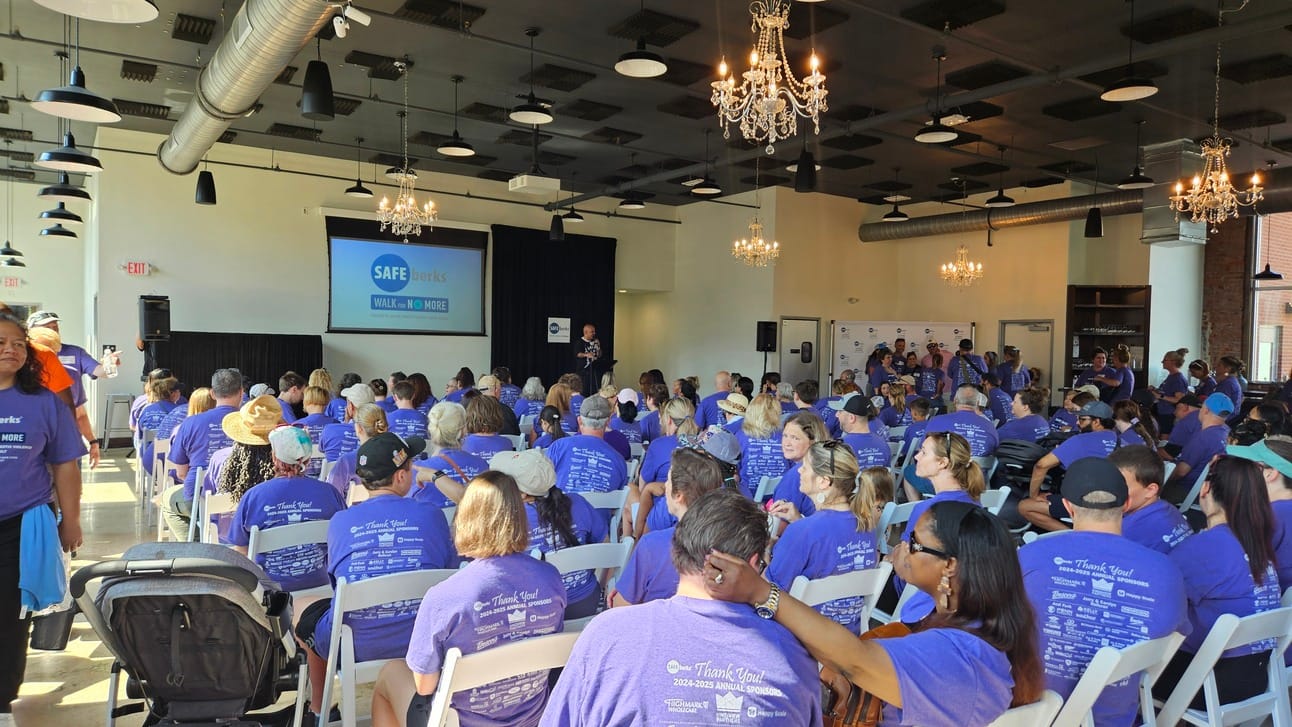
Walk participants gather inside Sly Fox Brewery prior to the opening presentation. (Katelynn Humbles)
That sentiment was powerfully underscored by a guest speaker – Sarah Phillips – a local businesswoman and survivor of domestic abuse. Standing bravely before a microphone, Phillips recounted how easily violence can hide in plain sight. “I was one of those people no one ever thought this could happen to,” she began. What started as her partner’s controlling comments — “Are you really wearing that? You should act more like a lady,” he would say — escalated over time into physical assaults. The first time he grabbed her, she said, “I didn’t get bruises, so I thought it wasn’t that big a deal. He apologized and promised never again.”
It did happen again. Sarah described the night she was beaten — left with bruises on her face, arms, and back, and literally running for her life. The audience stood silent, many visibly moved, as she detailed pressing charges and obtaining a restraining order. Safe Berks, she said, became her lifeline. “I don’t know what I would have done without them,” Sarah told us, voice wavering. She highlighted the Safe Berks advocate who stayed by her side through an entire day in court, providing steady support as her abuser was ultimately convicted. When she finished, the crowd erupted in supportive applause. “To anyone who might be suffering in silence,” Heather Adams had said earlier, “please know you’re not alone — Safe Berks is here for you whenever you’re ready.”
To anyone who might be suffering in silence, please know you’re not alone — Safe Berks is here for you whenever you’re ready.
The Walk for NO MORE is as much about empowerment and healing as it is about awareness. Safe Berks CEO Beth Garrigan took the stage to underline the broader mission. Next year will mark the organization’s 50th anniversary — five decades of providing a safe haven to victims who need support. Garrigan acknowledged that 2025 has been challenging — the year began with tragic domestic violence homicides in our county, and funding for services has grown uncertain. Yet, she expressed confidence that the community’s support will carry Safe Berks through.
“It’s been a lot of sleepless nights,” Garrigan admitted regarding funding hurdles, “but I know we’ve weathered challenges like this before — and we’ll do so again. Survivors need us.”
She highlighted that more people than ever are seeking Safe Berks’ help: six new bedrooms have already sheltered dozens of victims fleeing abuse. In a poignant aside, Garrigan noted a sign of progress: Pennsylvania recently expanded its protection-from-abuse laws to cover pets, meaning survivors can now include their companion animals on restraining orders — a big deal for those who might delay leaving out of fear for a beloved pet’s safety. Safe Berks is currently working to update their pet policies with their insurance company, and hopes to be able to accept pets this summer.
The morning also served to recognize those in the community making a difference. During a brief awards ceremony, Safe Berks presented its annual Voices for Change honors. One award went to Baja Beach Wellness – a women-owned local salon and spa – for rallying donations and creative fundraisers like a cryo challenge where customers tried freezing cryotherapy sessions with proceeds donated to Safe Berks. Another award honored Reading Area Community College (RACC) for its innovative partnership: RACC hosts a Safe Berks counselor on campus and even created a scholarship fund for survivors pursuing education. Hearing about these partnerships was uplifting — a reminder that the fight against abuse truly involves the whole community, from businesses to schools and volunteers. “Everyone has a role,” noted one Safe Berks staffer, thanking the volunteers, sponsors, and even the police officers who escorted our march.
As we gathered at the plaza outside Sly Fox Taphouse, there was a buzz of determination in the air. Many walkers were survivors or family members; others, like myself, were allies and concerned citizens. We set out eastward down the main street — which was closed to traffic for the day’s events — effectively turning the pavement into a stage for our message.
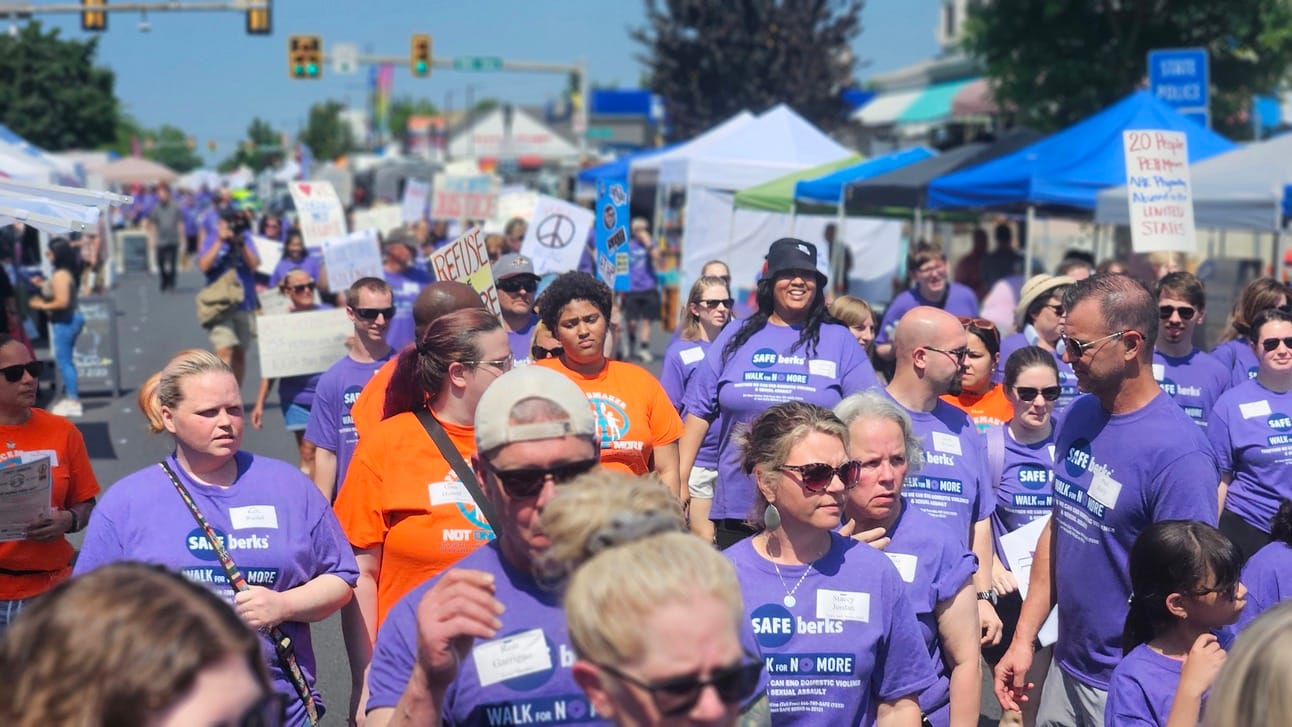
Safe Berks participants marching down Penn Avenue during the Walk for NO MORE. (Katelynn Humbles)
I found myself shouting along with the crowd: “No more domestic violence — no more sexual assault!” Those refrains, led by Safe Berks staff over a megaphone, drew supportive waves from shop owners and volunteers setting up festival tents along the sidewalks. A few early-bird art vendors paused their preparations to clap as we passed. Despite the heavy subject, the atmosphere felt hopeful. “Love should never hurt!” one sign proclaimed, bobbing above a sea of purple shirts. Strangers fell into step together, united by the idea that our community can and must say “no more” to abuse.
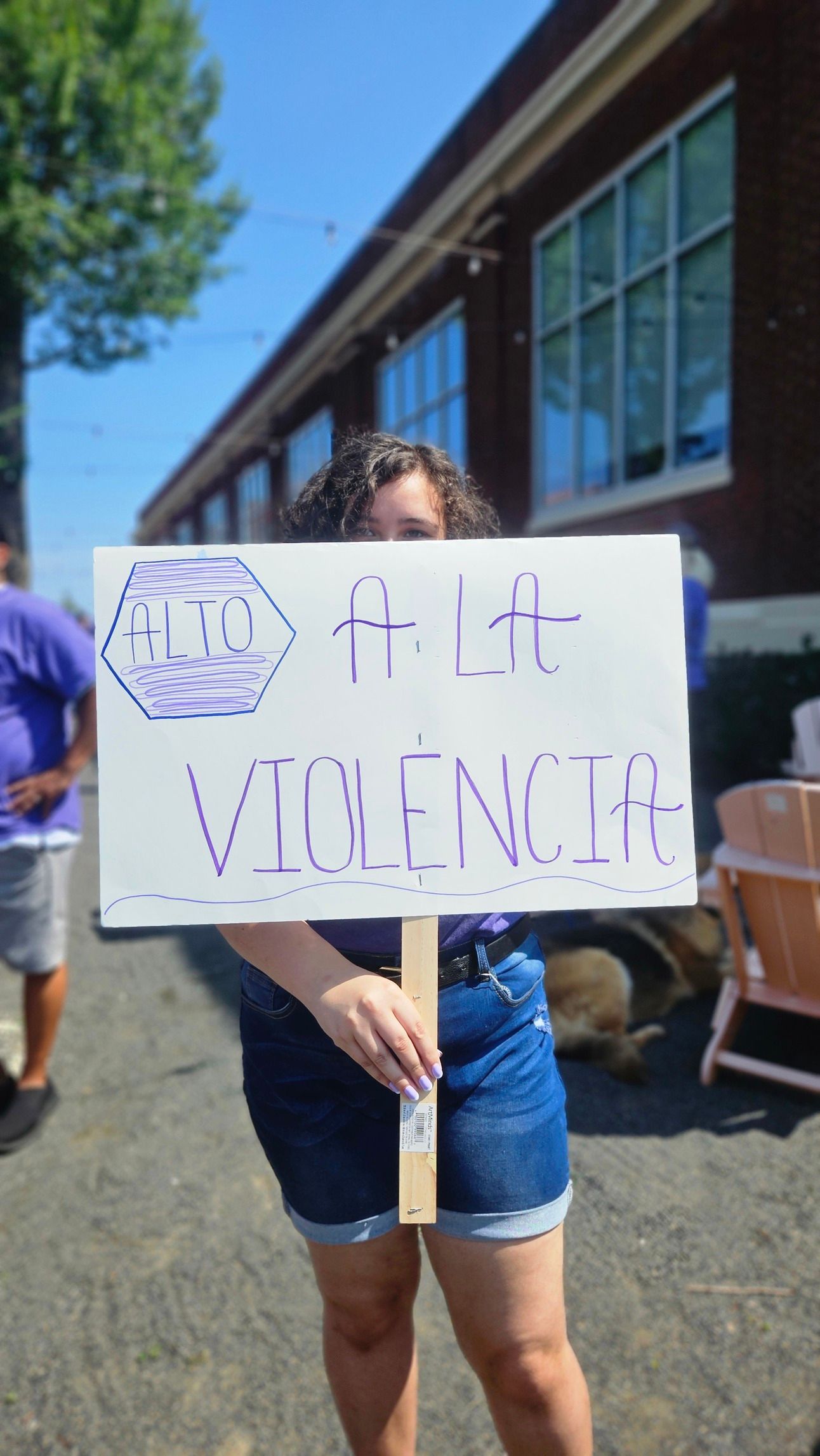
A participant holds up a sign reading "ALTO A LA VIOLENCIA" ("STOP THE VIOLENCE") during the march. (Katelynn Humbles)
By 10:30 a.m., our Walk for NO MORE was wrapping up with a final flurry of chants: “Hey hey, ho ho — domestic violence has got to go!” As we finished the route at 4th Avenue amid cheers and high-fives, I took a moment to absorb the scene. The street had been claimed for a cause, however briefly. In our wake, a symbolic sea of purple-shirted walkers dispersed — many planning to stick around for the festivities to come. Indeed, all around us, Penn Avenue was beginning to blossom into an open-air festival.
It’s no coincidence the events were scheduled back-to-back; the West Reading Community Revitalization Foundation coordinated closely with Safe Berks so that the Walk would lead directly into the festival. With barely a breather in between, West Reading seamlessly shifted gears from advocacy to artistry. At 11:00 a.m., the barricades that had kept cars off Penn Avenue remained in place — but now the sidewalks and street filled with colorful vendor tents, art displays, food trucks, and live music. It was time for Art on the Avenue – Berks County’s premier annual art and music festival. This year marked the 31st annual Art on the Avenue, and it was bigger than ever. Spanning the 400 through 700 blocks of Penn Avenue, the festival boasted over 200 vendors — a record of 205 by the final count. Not bad for an event that began decades ago as a little one-block street fair.
“It used to be just a block long, very small. It’s slowly evolved over time,” says Nick Price, Main Street Executive Director of the West Reading Community Revitalization Foundation. Now Art on the Avenue is a massive undertaking, drawing tens of thousands of visitors. Last year’s attendance was estimated at around 21,000, and this year, with expanded programming and a larger footprint, the crowd swelled to more than 30,000.
Walking back up Penn Avenue in the early afternoon, I was struck by the transformation. Just an hour earlier I’d been marching down this same street chanting for social change; now I was navigating through throngs of smiling festival-goers carrying artwork, funnel cakes, and iced coffees. The energy had shifted to something celebratory and bustling. The air was filled with music from multiple stages and the aroma of kettle corn and barbecue.
“Events like Art on the Ave aren’t just about art and music. They’re major economic drivers,” Nick Price told me earlier, and I could already see what he meant. Local boutiques and cafes along Penn Ave were buzzing with customers ducking in to shop or cool off. Every few feet, another friendly face handed out brochures or freebies. Price noted that some shops report Art on the Avenue as their single busiest sales day of the year — a crucial boost for small businesses heading into the slower summer months. By design, the festival prioritizes local and small vendors over big corporations. Of the 205 vendor spots, only seven were taken by large corporate entities.
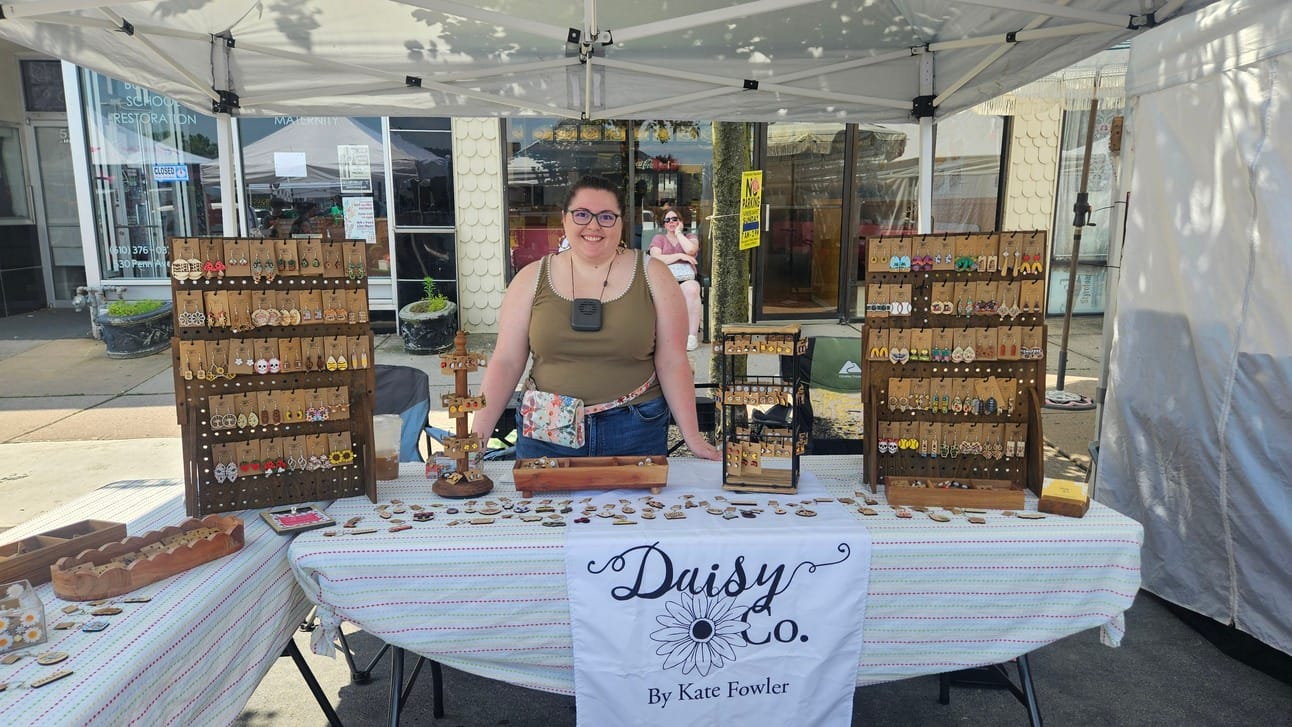
Artist Kate Fowler at her booth, Daisy Co., where she collaborates with two other women to create wood burned and hand-painted jewelry and trinkets. (Katelynn Humbles)
“We give West Reading businesses first priority, then small independent artists and crafters,” Price explained. “We want to keep the authentic spirit of the Avenue. It’s way cooler to walk around and see stuff like a local artisan’s hand-crafted jewelry or paintings than to get hawked by someone selling, like, replacement windows,” he added with a laugh. Even the few corporate vendors present were encouraged to offer interactive activities — this family-friendly festival isn’t a trade show, after all.
The result was a vibrant showcase of regional creativity. Strolling the four-block stretch, I encountered painters doing live demonstrations, photographers displaying prints of Berks County landscapes, and jewelry-makers proudly explaining their techniques. Under a tent near 6th Avenue, the local Art Plus Gallery featured winners of Plein Air West Reading – a week-long event where artists had been painting outdoor scenes around town leading up to the festival. Their freshly-finished canvases — capturing familiar West Reading street corners and Berks countryside vistas in various styles — hung for sale, still faintly smelling of acrylic and oil. This competition, now in its 10th year, adds an extra dash of artsy excitement to festival week, and the winners’ tent drew many curious visitors.
What I love about Art on the Avenue is how accessible it makes the arts. You don’t need to visit a gallery or have a big budget — you can chat with an artist right on the sidewalk, learn the story behind a piece, maybe take home a small print or craft for $20. I spoke with Phyllis Moser – a Berks County artist who had set up a booth – of her whimsical watercolor paintings. “Most people I work with don’t even realize I’m an artist,” Moser told me, smiling as she offered a sticker with her Instagram handle. “Events like this are about getting people to actually see what I do. Sure, I’d love to sell some pieces or get a commission, but today I’m really here more to put myself out there — to connect.”
Sure, I’d love to sell some pieces or get a commission, but today I’m really here more to put myself out there — to connect.
Of course, it wouldn’t be Art on the Avenue without music and food completing the sensory feast. This year’s festival featured live performances on three stages scattered along Penn Street. Beginning at noon, bands and solo acts played almost nonstop — offering everything from folk and indie rock to jazz. By late afternoon, the main stage at 6th & Penn was packed shoulder-to-shoulder as people gathered for the headline act: Sponge, the platinum-selling alternative rock band from Detroit that made waves in the ’90s. Seeing a nationally-known band play for free on a small-town street was surreal and exciting — the crowd sang along to Sponge’s hit Plowed with palpable nostalgia.
“If there’s someone you really want to see, you have to catch them here,” Nick Price mentioned about the music lineup. “We never repeat the same acts at our other events throughout the year, so Art on the Ave is always a fresh experience.” True to that ethos, many of the day’s performers were new to the West Reading scene, and they drew enthusiastic applause. If Sponge’s grunge anthems weren’t your cup of tea, you could wander down the block to find an acoustic singer-songwriter under the 7th Avenue tent, or a jazz trio grooving outside a café.
Amid the tunes, food vendors and local restaurants kept everyone fueled. I indulged in a street taco from a pop-up stand, then later cooled down with an ice cream cone from an iconic Penn Avenue creamery. With the sun high in the sky, families found shade under the new community tent that organizers had set up in a nearby parking lot — a recent addition meant to encourage people to sit, eat, and mingle. This year, the festival footprint extended farther than ever, even incorporating a portion of Tulpehocken Avenue and a corner lot for extra vendor space and seating. With a waiting list of over 50 would-be vendors, organizers managed to squeeze in 34 more booths by adding just one extra block.
“It’s a good problem to have!” Nick joked, though he admitted that logistics and communication remain the most challenging aspects. He hopes to expand even further in the future if safety and infrastructure allow. In the early morning hours before the festival, Nick and his team were literally out on the street with chalk and measuring tape, carefully marking each booth’s boundaries on the asphalt. “Just a few inches off can throw off the whole block,” he explained, emphasizing the importance of leaving space for an emergency lane down the center. It’s the kind of behind-the-scenes diligence most attendees never notice — but it’s what makes the whole day feel effortless once the crowds arrive. Despite the scale of the event, it was organized and safe, with volunteers and police officers visible and approachable, happily chatting with attendees. The West Reading PD even had their own tent where kids received junior badge stickers and high-fives from the chief.
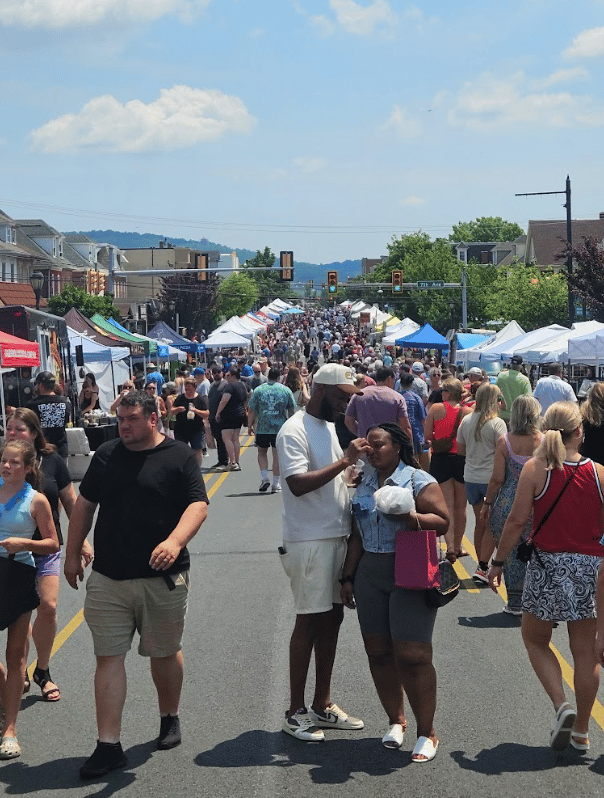
A large crowd explores vendor booths and live art displays during West Reading’s Art on the Avenue. (Katelynn Humbles)
As afternoon eased into evening, Art on the Avenue hit its peak. By 5 p.m., the street was a lively collage of sights and sounds: kids giggling as they tried a hula-hoop contest at one booth, art lovers carefully wrapping newly-bought paintings in brown paper, old friends clinking plastic cups of craft beer outside the Sly Fox beer garden, and a line forming at the funnel cake truck for one last sugary treat. The sense of community pride was almost tangible. I ran into neighbors I hadn’t seen in months and met visitors from out of town who were experiencing West Reading for the first time. One couple visiting from a few counties over told me they’d heard about Art on the Avenue on social media and decided to make a day trip. “This is amazing — we had no idea this town was so cool,” the husband said, noting the mix of old buildings and vibrant new life on the streets. His wife nodded while admiring a handcrafted necklace she’d just purchased. “We’ll definitely be back next year,” she said, and I believed her.
As Sponge finished their set with an encore and dusk approached, the festival officially began winding down — though not before an after-party at the West Reading Motor Club kept music lovers dancing a bit longer. Exhausted but happy, I made my way home reflecting on everything I’d witnessed that day.
It’s not every day that a small town can pull off two major events back-to-back — one a rally for social change, the other a sprawling celebration of the arts — and make them both resounding successes, but West Reading did exactly that. The Walk for NO MORE in the morning and Art on the Avenue through the afternoon and evening might have been very different in tone, yet they felt complementary in the best way. Both were about community members coming together in public spaces, expressing themselves, and supporting one another. As I think back on Saturday, a particular comment from Nick Price sticks with me: “Events like these aren’t just fun happenings — they’re the fabric of our civic life.” They show what an engaged, compassionate community we have. We can raise our voices for difficult issues at 9 a.m. and then raise a toast to the arts by nightfall, all on the same main street.
Personally, as someone who cares deeply about my community, I felt proud to be a Berks County resident that day. From chanting “No more!” with survivors in the morning to cheering local bands in the afternoon, I experienced a full spectrum of what civic life here is all about: awareness, unity, creativity, and joy. It’s a testament to the organizers — Safe Berks, the WRCRF, and countless volunteers — that everything ran so smoothly. It’s a testament to the people of Berks County that so many showed up. In an age when it’s easy to feel isolated or divided, events like the Walk for NO MORE and Art on the Avenue remind us that we truly are stronger together.
By the end of June 21, as the last vendor tent was packed up and the final song faded into the warm summer night, one thing was clear: West Reading’s heart for community and its flair for creativity are alive and well, and when put together, they make magic on Penn Avenue. Here’s to many more years of saying “no more” to violence, saying “yes” to art, and coming together as neighbors for the common good.
Katelynn Humbles is a writer, visual artist, and journalist based in Reading, Pennsylvania. With bylines in Cabin Fever and Berks County Living, her work explores the intersections of culture, community, and communication. She writes about Civic Life for Now Frolic. Find her on Instagram @katelynnhumbles or online at katelynnhumbles.journoportfolio.com.